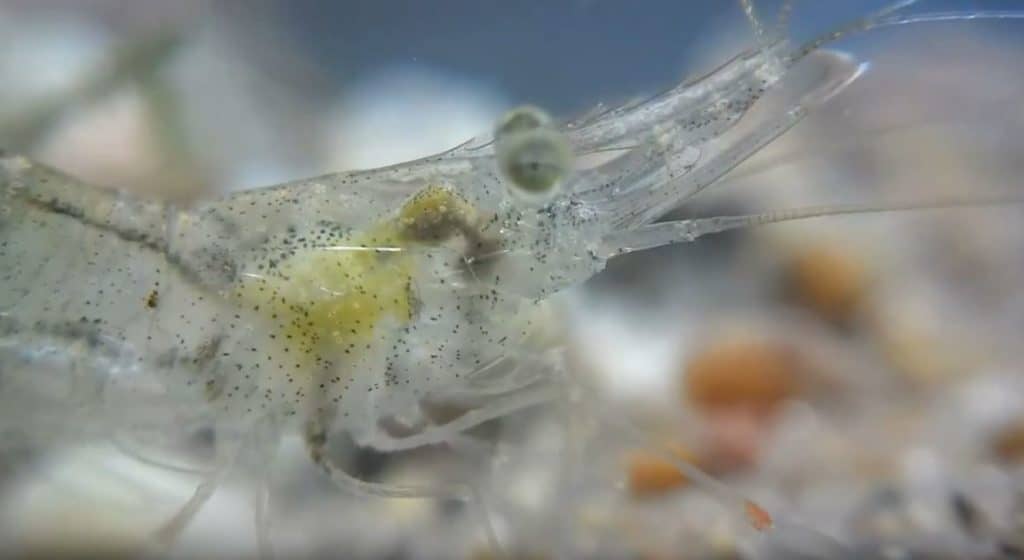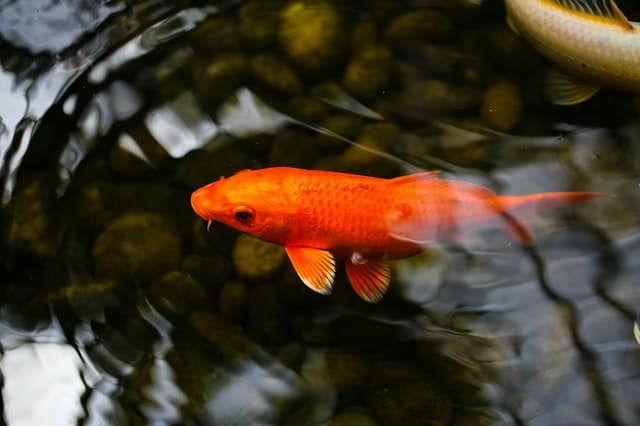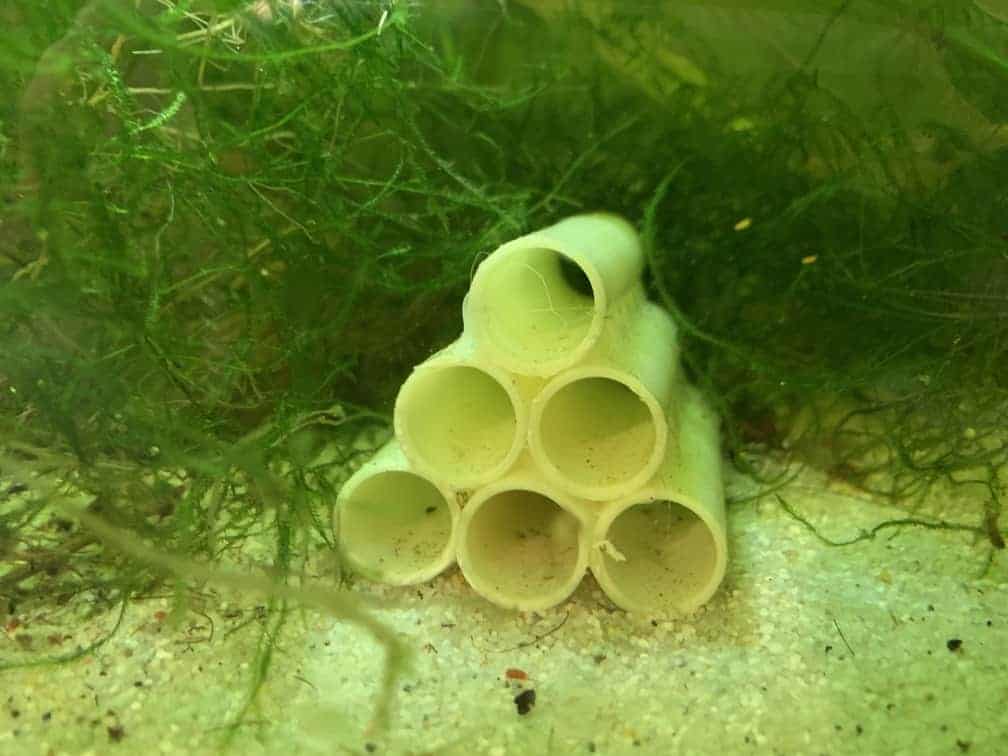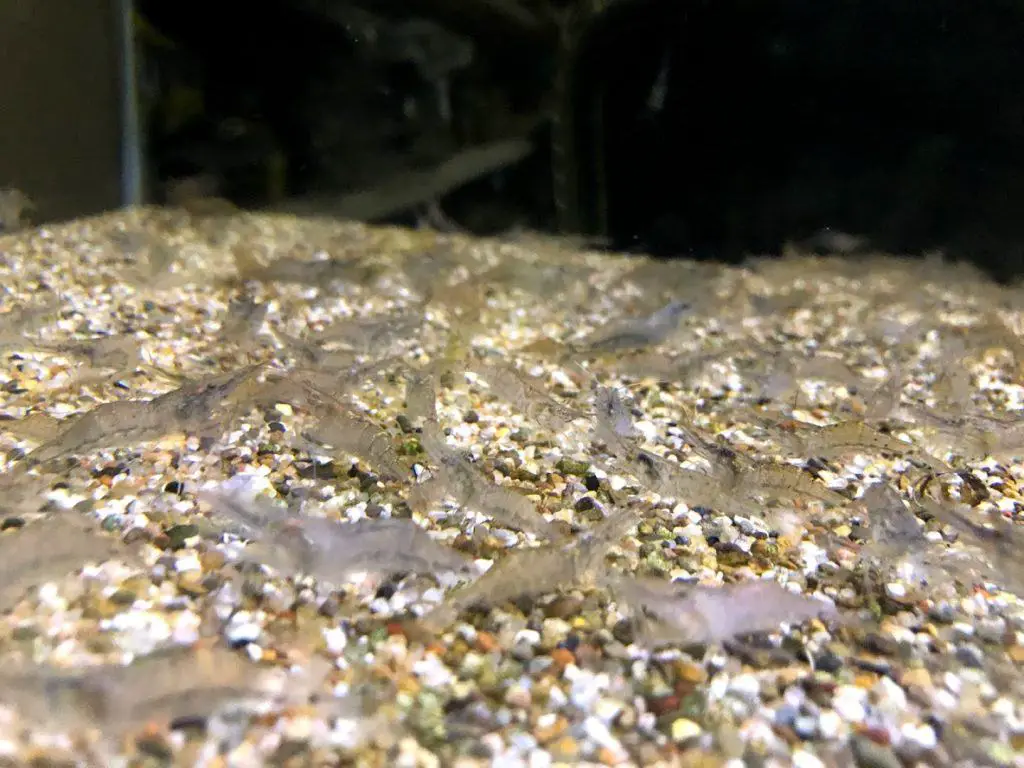Both ghost shrimp and goldfish are very popular for aquariums and ponds because of their tolerance to temperatures and water conditions. Can they live peacefully together? We will determine if and how their living conditions can be chosen to make this a success.
Can ghost shrimp be kept with goldfish? You can keep ghost shrimp with goldfish if your aquarium is big enough and have enough places for your smaller shrimp to hide. They require a similar temperature range and can be kept as tank mates if they are similar in size.

Keeping either ghost shrimps or goldfish alone can give you a beautiful aquarium to look at, but with a tank-mate, you can bring your aquarium to life. Although these two popular pets are not ideal together, this article examines these two’s compatibility as potential tank mates. We will find out what and how to create the right conditions to ensure a somewhat peaceful co-existence.
Therefore, goldfish are generally calm and should not significantly threaten the shrimp population.
Goldfish will predate the smallest of shrimp. The general rule about fish and shrimp applies here: If it fits in a fish’s mouth, it is food.
Ghost shrimps are scavengers and mostly live at the bottom of the tank, nibbling away at food pieces, whereas the goldfish are small free-spirited, and tend to move all around the tank. We shall look at the temperature requirements and water conditions, the type of food to be provided, any added features to the aquarium, the tank size, and the water quantity required per fish.

Can Goldfish and Ghost shrimp Co-Habitate
Goldfish have proven to stay peacefully with bottom feeders since their paths rarely cross. The tank size should be large enough to hold both species without overcrowding.
Generally, one goldfish requires a 10gal tank, whereas ten ghost shrimps can survive well in a 1gal tank; therefore, the tank size is mostly determined by the number of goldfish to be kept.
The goldfish and shrimp require water with an average PH of 6 to 8. Both these species are adversely affected by ammonia and nitrite levels. Regular monitoring of their concentration should be done.
Chemical and pollutant levels should also be maintained as shrimps have a low tolerance to their changes. Therefore, regular samples should be taken to the pet store to check chemical concentration levels.
Overfeeding and keeping uneaten food leftovers for long in the tank without cleaning increases the toxic levels. Both nitrite and ammonia are very harmful to the fish, and care should reduce their concentrations.
Nitrate has a minimum effect on fish and is generally required for adequate and healthy plant growth in the tank. However, a high concentration can affect the fish and should be kept between 5 and 10 ppm. Constant water changing will keep the chemical levels in the tank at the required range.
Safe Population for Healthy Growth
Goldfish will try to eat the shrimp, especially if their body sizes are large. To ensure the survival rate of the ghost shrimp, a few steps need to be taken. Keep live plants, caves, and/or ornaments in the aquarium. These will provide a hiding spot for the shrimps in case of an attack from the goldfish.
The plants should be placed sparsely as the shrimp tend to hide most of the time, and putting a lot of the plants in the tank will reduce the observer’s chance of ever seeing them.
Also, ghost shrimp with a large tank-mate in an open aquarium without hiding places have been observed to die after a short period from stress, if not from being eaten.
The survival chances of the shrimp population in goldfish’s presence directly depend on the number of ghost shrimps introduced to the tank. Even if a few ghost shrimps are eaten, others will repopulate, and the colony population will remain healthy. Considering the tank size we described above, a safe ratio of 1:10 of goldfish to ghost shrimp can be used to determine the number of shrimps to be kept.
Tank Requirements
Generally, ghost shrimps tend to be bottom feeders; when they are not in the open feeding, they tuck away in their hiding places.
Goldfish swim most of the time freely, and unless the goldfish are hungry or want to spice up their dull swim, the paths of the two hardly ever cross.

The ghost shrimp feed on growing algae in the tank, however, regular clean-up of the tank should still be done, and any food that has not been eaten should be regularly removed to prevent bacteria algae build-up.
A single algae pellet is enough to sufficiently feed a tank containing many ghost shrimp. Providing any more pellets leads to the risk of overfeeding. The nutrients from the pellets should be enough to maintain a healthy population of ghost shrimps. However, calcium supplements can be provided to ensure healthy outer casing formation.
Both species can be fed similar food types, and fish pellets or sliced cucumbers can be introduced to the tank. Both species tend to thrive in cold waters. Goldfish prefer a range between 74 and 84 degrees Fahrenheit, with ghost shrimp-like water temperatures ranging from 72 and 82 degrees Fahrenheit.
Therefore the tank should be kept around 77 degrees Fahrenheit for the two to be tank mates without stressing any of these two species.
Can Shrimp Harm Goldfish?
Some shrimp types are considered aggressive or fin and tail nippers, making them unsuitable companions for goldfish, such as whisker shrimps.
Research and observation were carried out to suggest that whisker shrimps tend to nibble at the slimy outer layer of goldfish, increasing the likelihood of disease attacks and pest attacks on the goldfish.
Therefore care should be taken to ensure the type acquired are ghost shrimps, both shrimps look identical, and the only visible difference is an orange band around the feelers and the front legs for the ghost shrimps.
Selecting Ghost Shrimp For Your Goldfish Tank
Ghost shrimps have a short life span, which makes them cheap. They are often bred as food for other animals. Feeder shrimp often reproduce under less-than-ideal circumstances and have short lifespans. When getting the shrimp, check whether they are bred for an aquarium or to feed other animals.
Why Do Ghost Shrimp Need Hiding Places In Your Fish Tank?
When the shrimp grow, their outer shell does not grow with it. Depending on the conditions provided, they have to shed their shell when they grow. They can frequently molt, leaving their outer shell at the bottom of the tank.

If you are unfamiliar with this process and look at this discarded shell, you might think the shrimp is dead. During this period, they are left unprotected without their hard outer case. The shrimp are vulnerable and need to hide until their outer shell hardens.
The discarded old outer shell should not be removed from the tank as it offers shrimps valuable nutrients.
Will Ghost Shrimp Reproduce In A Goldfish Aquarium?
There are several different translucent shrimp named ghost shrimp, and not all ghost shrimp types reproduce in fresh water. Some Ghost shrimp types need brackish water for the larvae to mature, but some ghost shrimp can reproduce in freshwater. If you have the freshwater reproducing type, they will reproduce if you have male and female shrimp.
You can take extra steps to increase the chance of repopulating ghost shrimp. Female shrimps can lay eggs after a couple of weeks and can be seen attached to their legs. After a few days, the male fertilizes the eggs.

To increase the probability of their hatching rate and prevent them from becoming food for goldfish, you can move the female to a breeding tank similar to the original. You should be very careful to prevent the female from dropping the eggs, which is common if they are stressed or if the change in water condition is too big.
After about three weeks, the eggs will hatch, and the mother can be moved back to the main tank. To prevent the young ghost shrimp from being eaten by the goldfish they should stay in the breeding tank until they have grown. The young can be fed on tiny particles of food. They should be transferred to the main tank after five weeks with the growth of full limbs.
You can let the adults just give birth in the aquarium with goldfish, and with enough hiding spots, some most likely will survive, but the goldfish will see them as food and hunt them until they are too big for the goldfish.
Conclusion
After looking at the conditions required at the tank, with proper feeding and temperature ranges, the goldfish and ghost shrimps can be placed together. Still, if the goldfish is big enough, they might not eat the adult ghost shrimp, but they will try and eat the smaller shrimp.
The key to keeping the goldfish from eating all the shrimp fry is to provide enough hiding places where they can live till they are big enough. Even with many hiding places, expect some of the less careful shrimplets to be eaten.
If you accept the occasional loss, you can have a beautiful goldfish aquarium or pond and have some busy Ghost shrimp cleaning after them.
Related Questions
Can goldfish be kept with cherry shrimp? Cherry shrimp and goldfish cannot be kept together. Goldfish will see the much smaller cherry shrimp as food due to their size difference.
